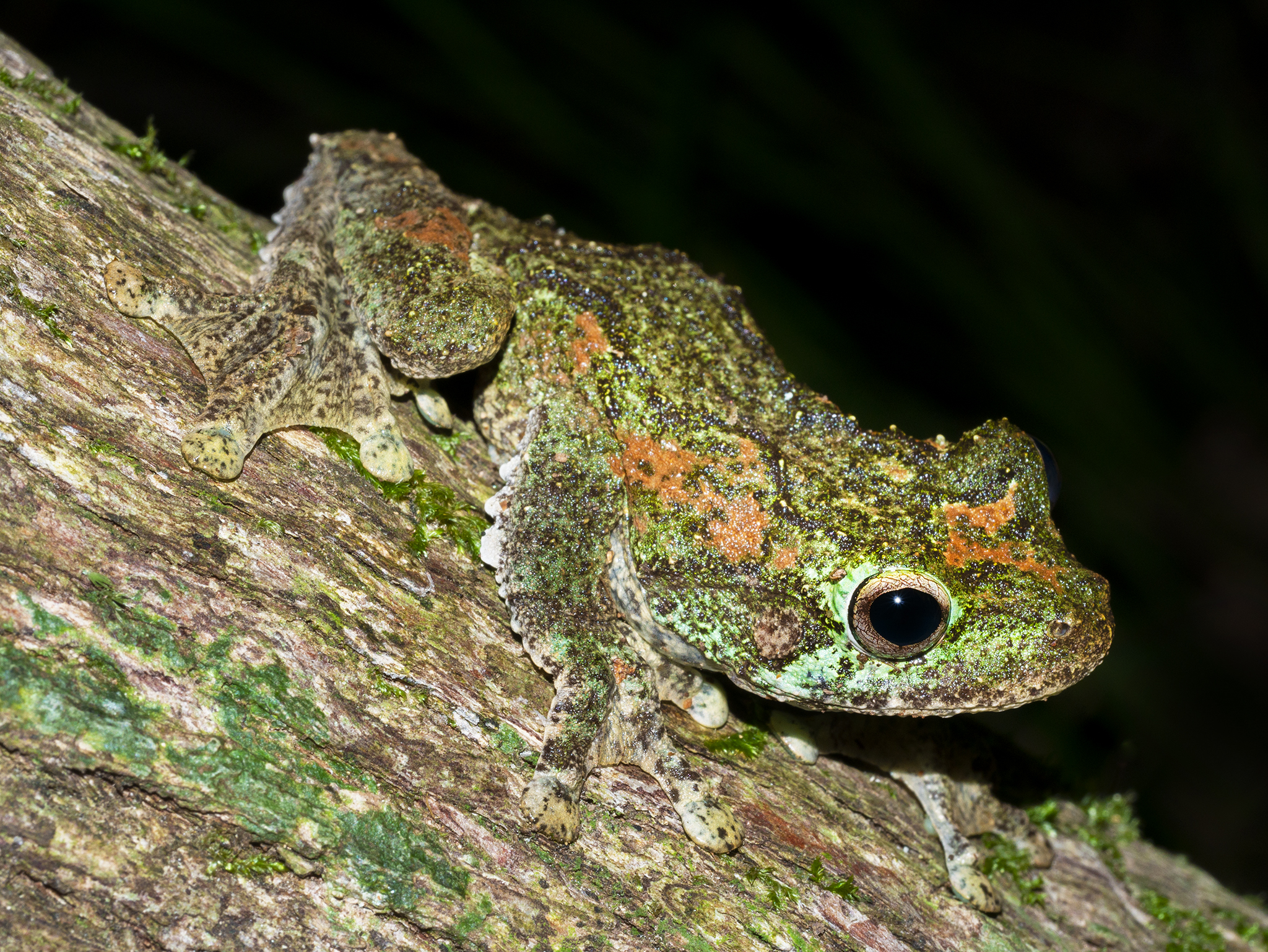How about that camouflage?!
This astonishing amphibian is the Green-Eyed Tree Frog. Found in the rainforests of Northern Queensland, these masters of disguise are best known for their incredible colours, patterns and textures.
Their markings are known to vary according to their habitat, ranging from bright green to rusty brown, but all have distinct splotches which are designed to mimic the lichen-covered rocks and trees upon which they are commonly found.

Green-Eyed Tree Frogs have remarkably mesmerising eye structures (Hypnotoad from Futurama anyone?), but despite their misleading moniker, they don’t actually have green eyes. Their common name actually comes from the green ring that encircles the eye on some frogs.
The species name ‘serrata’ also has an interesting origin. It comes from the rippled skin on the underside of the frog’s legs which resembles a serrated knife.
The frog above is an excellent example of both epithets.

Male Green-Eyed Tree Frogs are pretty lazy when it comes to impressing the ladies. While all the other frogs were evolving larger and larger vocal sacs in order to amplify their mating calls, the blokes of this species must have collectively decided they couldn’t be bothered.
Green-Eyed Tree Frogs don’t have a vocal sac, and consequently their mating call sounds like nothing more than a light tapping noise. However, the males have found a clever way around their shortcomings. Frogs of this species have been seen calling in groups of a hundred or more. They work together in order to attract females initially, but once they arrive it’s every frog from himself!

The Green-Eyed Tree Frog is probably the most photogenic frog I’ve ever come across. Between its enthralling camouflage and its intricate eye structure, it’s a truly captivating creature. It took me forever to narrow down to just seven photographs to include in this post – I couldn’t bear to cut any of them out!
However, that many photos requires quite a long post, and I’m not gonna lie… these frogs really just aren’t that interesting. I’m having to stretch my facts well beyond their merit at this stage.
But hey, I’ve committed to this now. No turning back. In for a penny, in for a pound. So you know what we’re gonna do?
We’re just gonna hang in there…

Okay, so I know I said these frogs were boring – and I honestly believed that until I came across this incredible evolutionary tale which blew my mind. These frogs definitely aren’t boring. I take it all back.
In a fascinating case study that appears to have been designed by Darwin himself, about a million years ago Queensland’s Green-Eyed Tree Frogs were separated into a northern and a southern population due to geographical changes. Around 7,000 years ago, these changes reversed and the two populations were once again able to intermingle.
Despite the north and south populations being able to breed successfully, the offspring of these north-south partnerships were found to be less successful than offspring produced by north-north or south-south partnerships. Consequently, the frogs in the north and south continued along their merry way, mating with their own populations as they had for the last million years – but in the small overlapping region, something remarkable was occurring.

In order to produce the healthiest offspring, southern females in this region learned to identify southern males by a slight variation in their mating calls, and then enthusiastically selected these males to mate with – but perhaps a little too enthusiastically. The selective pressures put on the southern males in this region incentivised them to become ‘more southern’, and consequently, in an effort to stand out to the picky southern females in this tiny zone, they evolved much more rapidly than the populations to the north or the south.
The result was that in the space of just 7,000 years – the blink of an eye on evolutionary time scales – the southern frogs in this small overlapping region evolved into an entirely new species, now known as the Kuranda Tree Frog (Ranoidea myola). This is one of the most amazing evolutionary stories I’ve come across.
Despite Green-Eyed Tree Frogs in both the southern and northern regions still being able to mate with each other (and therefore remaining the same species), the Kuranda Tree Frog is now unable to mate with either species, and has a significantly different call.

Although the evolution of new species typically happens over millions of years, in unique circumstances such as those experienced by the Green-Eyed Tree Frog, this process can occur with incredible speed.
Sadly, however, while Green-Eyed Tree Frogs are thriving, the rapid evolution of the Kuranda Tree Frog in such a tiny region means that they are critically endangered. Consequently, scientists are advocating for the protection of their habitat not just for the sake of the frog itself, but also for the incredible example of rapid evolution that it represents.
–
Green-Eyed Tree Frogs (Ranoidea serrata), Mount Hypipamee & Daintree Rainforest, Australia


